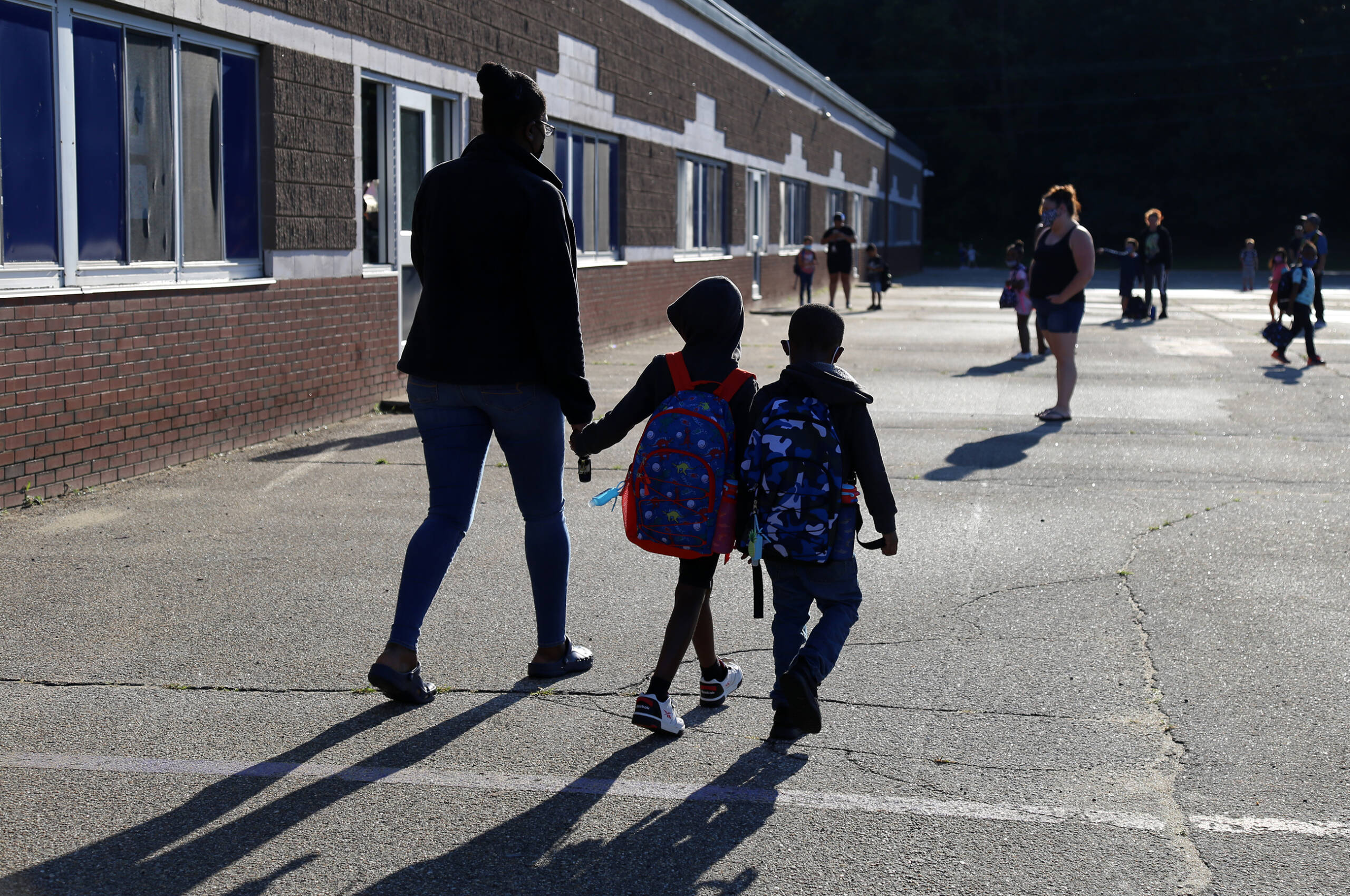

MAIN STORY ⇒ Substitute teacher shortage strains school systems
SIDE BAR ⇒ Lack of protections, student misbehavior challenge substitutes
Around the country, schools are getting creative with solutions to address what educators call a chronic shortage of substitute teachers. In New Mexico, the Governor called members of the National Guard into classrooms in 2022. In Oklahoma and North Carolina certain state employees can take paid time off in order to substitute.
Here in New Hampshire, there have been no attention-grabbing headlines, but plenty of scrambling in administrative offices to make sure teacher absences are covered and students can continue learning, administrators say. And that scrambling takes a toll on students and educators, they say.
Having enough substitutes “would bring a level of calmness to the schools,” said Jeremy Rathbun, assistant superintendent of SAU 93, the Monadnock Regional School District.
And yet, there are no quick fixes to the substitute shortage, said Heather Peske, president of the National Council on Teacher Quality (NCTQ), a Washington D.C.-based think tank that researches educational issues. Instead, Peske and other experts say that increased pay, investments in the teacher workforce, better data about shortages and a change of thinking about the value of substitutes are the only way to build a robust pool of substitute teachers.
“Substitutes really need to be considered as part of the teacher workforce that’s essential and critical for students’ experiences in schools,” Peske said.
A problem not measured
It’s difficult to get precise data about the state of substitute teaching in New Hampshire. The state Department of Education (DOE) doesn’t collect data on substitutes, since they require no licensing, according to Kimberly Houghton, communications administrator for the DOE. The department distributes a critical shortage survey to gauge teacher shortages, but that doesn’t include any questions about substitutes, Houghton said.
The Granite State isn’t alone in this problem.
“It’s a problem across the nation,” Peske said. Since substitutes are hired and tracked by individual school districts, there is little state-wide or national data, she said.
“We need a data system, and right now we have data silos,” she said.
Megan Tuttle, president of the New Hampshire chapter of the National Education Association, the state’s largest teacher’s union, says having a better picture of the substitute shortage is essential for addressing it.
“If we do want to fix it, you need to know how big the problem is,” she said.
Last year, the state legislature established a Committee to Study New Hampshire Teacher Shortages and Recruitment Incentives. In December, the committee recommended that the DOE add a position to “support ongoing research and data needs” around the teacher shortage. (The DOE couldn’t immediately be reached for comment on this recommendation).
Experts: Increased pay is a starting point, but policy changes also needed

The most immediate way to attract more substitutes is by increasing pay, Peske said. NCTQ collected data on substitute pay in the largest 150 school districts in the country, which includes Manchester. The organization found that pay ranges widely, from $9-$30 an hour, Peske said.
The average pay for substitutes increased nearly 20% between 2020 and 2022, to $15.50 per hour. And yet, the shortage of workers remained.
That national data mirrors what local New Hampshire districts have experienced. Last year, the Berlin School District (SAU 3), Contoocook Valley School District (SAU 1), Manchester School District (SAU 37) and Monadnock Regional School all raised their rates for substitute teachers, but still struggled to hire, administrators from the districts said.
“We feel like we’re competitive with money and we’re still struggling,” Rathbun said.
Tuttle said that New Hampshire doesn’t have enough teachers in general, which she believes contributes to the substitute shortage.
“If we didn’t have a lot of reasons for the shortage of teachers, the sub shortage might not be as bad as it is,” she said.
Policy changes could help attract more teachers to New Hampshire, she said, which would have a trickle-down effect on the substitute shortage.
For example, New Hampshire has a probation period of five years for new teachers, during which time teachers can be fired without cause, she said.
“This shows educators that we don’t really trust you,” Tuttle said.
The teacher’s union would like to see that reduced to a three-year period, in line with how often teachers need to renew their certification through the state.
“If you don’t know if someone is going to be a good teacher within the first three years, there are bigger problems,” Tuttle said.
In addition, Tuttle, along with the Committee to Study New Hampshire Teacher Shortages and Recruitment Incentives, suggests student loan forgiveness for teachers who work in rural areas and areas with a critical shortage of teachers. Those recommendations from the committee were integrated into two bills this spring, HB 632 and SB 217, but so far both remain in committee and neither has been passed.
Student teachers present a possible solution, with limitations
The Monadnock School District regularly takes student teachers from Keene State University, said Rathbun. These college students give instruction under the watch of a certified teacher, but they also provide critical support when the classroom teacher they’re working with is out sick, Rathbun said.
“That’s been really helpful,” he said. “It’s a great opportunity for them to get practice with kids they know, it gives us that coverage, and the classroom is still moving forward rather than just getting through the day.”
Nationally, researchers have suggested that student teachers could fill gaps in the substitute workforce. Since New Hampshire doesn’t require substitutes to have a college degree, college students are eligible to substitute, and do so in some of the districts that spoke with the Collaborative.
Keene State student teachers must have permission from their program and the mentor teacher that they are substituting under to begin subbing during their student teaching hours, said Tanya Sturtz, chair of the education department at Keene State College. In small doses, substituting can enhance their education.
“Student teachers often can learn a great deal by being exposed to different grade levels and a diverse range of students,” she said by email.
Since the pandemic, Keene State has allowed student teachers to complete up to 12 days of subbing each semester, in part to help the school systems facing a substitute shortage, Sturtz said. However, the total number of subbing hours are limited because mentorship and the classroom relationship with students are such important parts of the student teaching experience, she said.
“It can become disruptive to their learning if they are consistently removed from their classrooms,” she said.
At Southern New Hampshire University (SNHU), most student teachers can act as paid substitutes with permission from their academic program, said Audrey Rogers, associate dean of Graduate Education Programs. The school weighs many factors when considering those requests, including whether the student teacher will be able to continue to work closely with their mentor. While student teachers can help alleviate the substitute shortage, they’re not a solution to the systemic problem, she said.
“There is no short-term solution without compromising the quality of the student teaching experience,” Rogers said in an email. Ultimately, the solution lies in educating more teachers, she said.
A change of thinking around substitute teachers is also needed, Peske said. She would like to see districts specifically recruiting, investing in and paying substitute educators more. That should include integrating substitutes into professional development days, teacher evaluations and trainings, she said.
“Districts could be more strategic in thinking about subs as teacher workforce rather than individuals that fill gaps,” she said.
 These articles are being shared by partners in The Granite State News Collaborative. For more information visit collaborativenh.org.
These articles are being shared by partners in The Granite State News Collaborative. For more information visit collaborativenh.org.







